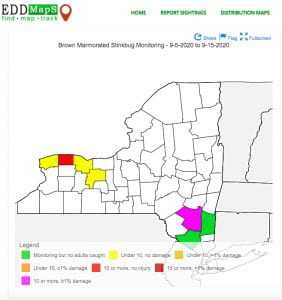
Overview: The brown marmorated stink bug (BMSB), Halyomorpha halys (Stål),is an Asian invasive arboreal pest in urban and agricultural environments, residing and feeding on a broad range of host plants. Significant and economic injury to tree fruit and vegetable crops has been well documented since 2011. Overwintering populations of the insect reside in man-made structures, causing home pestilence, provides the insect with this biological advantage in the cold climates of the northeast. The green stink bug, Chinavia halaris (Say), is also highly polyphagous arboreal insect having many host plants, and is a common pest of seeds, nuts and fruit in both the nymph and adult stages across the northeastern states. Both of these insects are a late season threat to pome fruit.
Action Threshold: The populations of brown marmorated stink bug have been steadily on the rise this season (Graph 1). Heat and drought conditions during the past three months have provided idyllic conditions for survival and reproduction. Very high nymph numbers have been recorded throughout much of the region and are now transitioning to adults in the southern Hudson Valley. BMSB adults have exceeded the 10 adult per week per trap threshold in many Hudson Valley sites. Both green and brown marmorated stink bug were also found feeding in pears and peaches this week, requiring management in orchards where BMSB are observed on fruit. Along with aggregation pheromone based trapping of BMSB using 10 adults / trap / week, observations of adults on the trees during scouting are a strong of feeding and indication that management should begin and or continue.
Simply looking forward, weather conditions over the next ten days are conducive for BMSB population increases that may give rise to movement from the woodland edge into orchards followed by fruit feeding resulting in economic injury as the weeks progress. Traps with duel lures to attract green and brown marmorated stink bug placed along the orchard perimeter near woodlands wooded of tree fruit orchards should be monitored closely for increasing movement of the pests into orchard blocks.

Pest management challenges: As we approach harvest, populations of adults will increase while the volume of fruit on the remaining trees will decrease, intensifying damage feeding by stink bug to these late varieties remaining on the tree. In years past we have seen varieties harvesting in mid-September begin to express high levels of fruit injury in high pressure blocks. This implies that management to these varieties should begin from mid-late August and up to harvest. Most pronounced injury in the Hudson Valley has been observed on late peaches, Bartlett and Bosc pear, Red Delicious, Empire, Golden Delicious, Ruby Frost, Fuji and Pink Lady apple.
BMSB simply does not fit traditional IPM models for management. Damage appears 7-14 days after fruit feeding requiring prophylactic management based on trap and scouting observations. The insect aggregates in late season flight to crops, migrating to and from woodlands to tree fruit. The insect has a large body mass and even when feeding, has minimal exposure to the insecticide requiring high insecticide rates for residual contact. Pre-overwintering feeding activity of BMSB in the orchard requires late season insecticide residue. Yet late season applications may exceed MRL’s, especially under drought conditions if rains that are needed to wash off residue are belated.
Stink Bug Management: The majority of insecticides when applied directly or as residual produce mortality to the target pest. As we approach harvest, essential considerations for insecticide decision-making using these materials should include insecticidal efficacy, effective use rate, residual activity and pre-harvest intervals.
The link to a list of BMSB management insecticide decision making providing an ‘Efficacy Comparison of BMSB Insecticide Tools for Orchard Tree Fruit Management’ for pyrethroids, neonicotinoids and pre-mixed tools can be found here.
New York growers have again received a Section 18 Exemption for the use of products containing bifenthrin this season to control brown marmorated stink bug on apples, peaches, and nectarines this year in designated counties including Columbia, Dutchess, Orange, Ulster, Monroe, Orleans, Wayne and Niagara Counties this year. Use in any other counties is prohibited. in New York State. is an excellent material for contact and residual management of BMSB on tree fruit. Regardless of the product used, a maximum of 0.08 to 0.2 lb[AI]/acre/season will be allowed, with no more than 0.5 lb a.i./acre applied per year with multiple applications made at a minimum of 30 day intervals; a restricted entry interval (REI) of 12 hours and pre-harvest interval (PHI) of 14 days must be observed.
When applying either of these materials for BMSB control on apples, peaches, or nectarines, growers must have possession of the Section 18 label.
Bifenture 10DF Insecticide/Miticide (EPA Reg. No. 70506-227)
Bifenture®EC Agricultural Insecticide (EPA Reg.No.70506-57)
Brigade WSB (EPA REG. NO. 279-3108) which need to be on hand during applications.
What to do within 7 days to harvest
Keeping BMSB from feeding on the fruit is at the crux of our stink bug management program as we near harvest. Killing the insect as it moves into the orchard and onto the fruit is the traditional method of crop protection and proven to be very effective. Yet limitations, based on the material pre-harvest intervals constrain their use near harvest. There are no effective pyrethroids, neonicotinoids or pre-mixed insecticide tools that permit their use within the 7-day to harvest window with very few options available during the days prior to fruit harvest.
A Novel Mode of Action: The development of newer classes of insecticides that produce an anti-feeding response in the pest provides an additional mode of action for BMSB management. Both Corteva insecticide Closer 240 SC (classified as a Group 4C insecticide / neonicotinoid – 7 DTH) and Venerate XC (microbial-based insecticide with multiple modes of action and 0 DTH) have anti-feeding activity against BMSB. The 0 DTH of Venerate provides BMSB management up to the day of harvest under high risk conditions.


